Nerve Growth Factor
Introduction
Nerve Growth Factor (NGF) is a member of the neurotrophin family of growth factors, which are involved in the regulation of growth, maintenance, proliferation, and survival of certain target neurons. It was the first neurotrophic factor to be discovered and remains one of the most studied in neuroscience.
Discovery
NGF was discovered in the 1950s by Italian neurologist Rita Levi-Montalcini and biochemist Stanley Cohen. Their discovery of NGF and its role in the survival and development of neurons was a significant breakthrough in neuroscience, earning them the Nobel Prize in Physiology or Medicine in 1986.


Structure
NGF is a small protein molecule, or polypeptide, composed of 118 amino acids. It is a dimer, meaning it consists of two identical subunits, which are held together by strong bonds called disulfide bridges. These subunits form a characteristic "cystine knot" structure, which is common to all members of the neurotrophin family.
Function
NGF plays a critical role in the survival and maintenance of sympathetic and sensory neurons. It is produced by tissues innervated by these neurons and taken up by nerve terminals, from where it is transported to the cell body. This process, known as retrograde transport, is essential for the survival of the neuron.
NGF binds to two types of receptors on the surface of neurons: the high-affinity receptor TrkA and the low-affinity receptor p75NTR. Binding to TrkA triggers a cascade of intracellular events leading to neuronal survival, differentiation, and growth. Binding to p75NTR, on the other hand, can lead to cell death or survival, depending on the cellular context.
Role in Disease
Alterations in NGF signaling have been implicated in a number of neurological disorders. For example, decreased levels of NGF are found in the brains of patients with Alzheimer's disease, and it is thought that this contributes to the degeneration of cholinergic neurons seen in this condition. Conversely, increased levels of NGF have been associated with inflammation and pain, as NGF is upregulated in inflammatory conditions and can sensitize pain receptors.
Therapeutic Potential
Given its role in neuronal survival and growth, NGF has been explored as a potential therapeutic agent in a variety of conditions. In Alzheimer's disease, for example, strategies to increase NGF levels in the brain are being investigated. These include gene therapy approaches, where the gene for NGF is inserted into cells, and the use of NGF mimetics, which are small molecules that can mimic the action of NGF.
In conditions associated with pain and inflammation, strategies to block NGF action are being explored. These include the use of antibodies that can bind to NGF and prevent it from activating its receptors, and small molecule inhibitors that can block the activity of the TrkA receptor.
